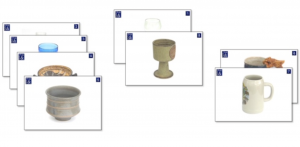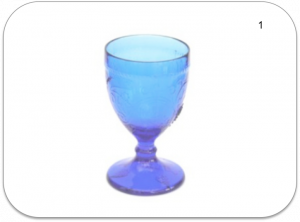Overview
The way people categorise objects or concepts varies between individuals. Sometimes people aren’t even aware of how they categorise objects or concepts until they think about it.
Card sorts are useful for finding out how people categorise things, including products and services. The results are often unexpected, and give new insights.
The image below shows a sorting session in progress.

Sorting is a powerful way of discovering how individual people categorise things, and how much agreement and disagreement there is between individuals.
You can ask people to sort real objects such as mobile phones or rock samples, and there are advantages in using the real thing if touch or smell are key features of the person’s categorisation. However, cards showing text or pictures are much more manageable, and are suitable for most purposes.
In a card sort each card shows a picture, or text such as a product name. Each card is given an identifying number.

We ask people to sort the cards repeatedly into groups (categories) of their own choice, using their own criteria. For each different criterion, we record which cards are in which category, using the identifying numbers on the cards.


Demonstrate the sorting process with the mini pack
The videos here show card sorting in progress. One video has the participant thinking aloud in English; the other has the same participant thinking aloud in Kurdish.

Give your main pack to the participant so they can sort it.
Tip: Don’t let them see the main pack until you’ve finished your demonstration, or they’ll start sorting before you’ve finished explaining.

The participant sorts the main pack into groups of their own choice
Tip: If they have trouble thinking of categories, choose two cards at random, and ask what the main single difference is between them. This can then be used as the basis for a further sort.
Tip: Don’t comment on their categories, no matter how strange these are; usually, the categories make much more sense later.
Tip: If you think that they are trying to use two criteria for sorting at the same time (e.g using a group called. big and expensive) then check tactfully, and clarify that they can sort on each criterion in a separate sort (e.g. one for size and one for cost).

Record which cards went into which groups, and record what the overall criterion was for the sorting. (e.g. if the groups are high, medium and low, you need to know what is high, medium or low).
The two boxes below show how this is done for the sort shown in the image above. The first box contains the participant’s description of the sort; the second box shows how this sort is recorded. Note the commas between numbers, so you can tell the difference between 1,2 and 12 when using more than ten cards.
The two boxes below show how this is done for the sort shown in the image above. The first box contains the participant’s description of the sort; the second shows how this sort is recorded. Note the comman between numbers, so you can tell the difference between 1,2 and 12 when using more than ten cards.


Repeat the process using a new criterion for sorting
You continue repeating the process until:
If they want to keep going, and need a nudge, you can again choose two cards at random and ask for the main single difference between them, and then use this as the basis for another sort.

You can analyse the card sorts results in various ways, including:
Andy Hurd’s thesis contains excellent examples of how to conduct and analyse card sorts, including cross-cultural, theoretical and methodological issues.

Card sorts are good for finding out which categories people consider important, but they don’t tell you why a participant considers a particular category important, or what they mean by something. To get this broader context, you can use:
For example, a participant may sort drinking vessels on the basis of how much the vessel holds during a card sort, and then explain during upward laddering that this is significant to them because a vessel that holds more will require fewer refills. This identifies getting refills as being a significant issue, and a potential opportunity.